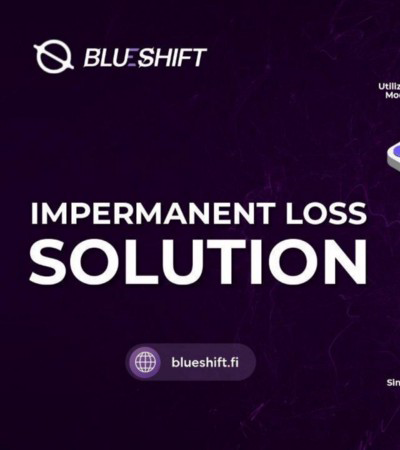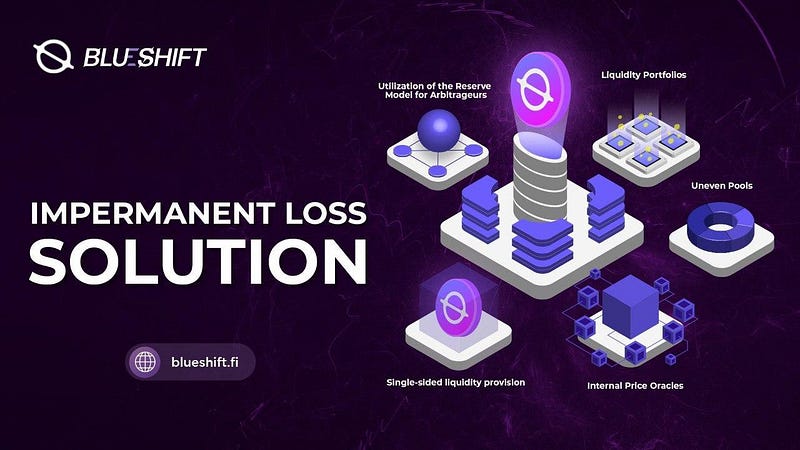Blueshift’s Impermanent Loss solution
Apr 8, 2022


The Blueshift team took three different approaches to reduce Impermanent loss(IL) which ultimately led to a reduction of IL for Blueshift users by a factor of 2, up to a factor of 10. In other words, Impermanent Loss on Blueshift is commonly 10 times lower than on other DEXes.
Let’s examine each approach and how it impacts Impermanent Loss for Blueshift users.
Liquidity portfolios & Single-sided liquidity provision
Impermanent Loss is an occurrence that happens when the ratio of provided assets changes in a liquidity pool. This implies that if only a single asset is provided as liquidity in a liquidity portfolio with multiple cryptocurrencies — Impermanent Loss is significantly reduced.
By placing 3–40 different token types in a liquidity pool, which for the sake of differentiation and clarification, we call a liquidity portfolio — the impermanent loss is directly reduced due to changes of parameters that are part of the AMM formula. The correlation between the impermanent loss and the number of types of cryptocurrencies in a pool has been already described in a subsection titled ‘Number of token types in the pool’ which is part of the previous article.
The liquidity portfolio innovation will be utilized by Blueshift from the very beginning, as well as the following innovation: the ‘Blueshift reserve model’.
Utilization of the Reserve Model by Arbitrageurs
One of the roles that benefit from impermanent losses is seemingly invisible but takes its cut nonetheless. The primary driver of impermanent loss is ultimately the price change of assets, which is a reflection of the ratio of tokens in a liquidity pool. In other words, trends primarily cause impermanent losses. However, arbitrageurs are one of the primary catalysts of price change actions on marketplaces.
It can then be said without question that, when an arbitrageur executes a net positive value transaction, a part of that net positive was essentially taken from the liquidity providers.
Blueshift’s solution to this occurrence is to get arbitrageurs to forgo a part of their profits in order to utilize the zero-fee or negative fee arbitrage that is offered by the platform. These ‘profits’ that arbitrageurs relinquished now stay in the pockets of Liquidity providers.
In other words, the Blueshift platform forgoes the arbitrageur’s fee, and in return, arbitrageurs provide a part of their net positive transaction to liquidity providers. And hence, the entire ecosystem benefits, because liquidity providing has even higher incentives, and almost automatically — a greater number of participants.
A different way of explaining this phenomenon is as follows. Due to smaller reserves used by the Arbitrageur, which are necessary to be used in order to execute a zero or negative fee arbitrage — the Impermanent Loss curve is skewed in favour of Liquidity Providers by temporarily modifying the ratio between assets. This in turn results in higher slippage for Arbitrageurs, however, it will commonly pay off for Arbitrageurs to utilize such a feature.
Internal Price Oracles
Price oracles allow for token price change to decouple from the token reserves themselves, which ultimately determine the ratio between assets and hence impermanent loss. If the price is changed without an arbitrage, or a standard trade, the reserves remain unchanged, and hence, impermanent loss remains unchanged as well.
Impermanent Loss on Blueshift — in numbers
In the following article ‘Impermanent Loss on Blueshift’ we will dive even deeper into Blueshift technology, crunch some numbers and get concrete data on Blueshift’s edge as a liquidity management platform.
To make sure you don’t miss it, follow our Twitter and Medium. If you’re eager to join our community, don’t hesitate to swing by our Discord!
For clarity, liquidity portfolios in this article were mostly referred to as ‘liquidity pools’. Liquidity portfolios are in essence — liquidity pools that contain more than just 2 types of cryptocurrencies.

